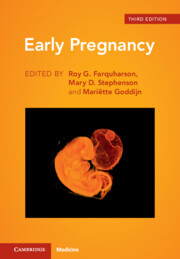Book contents
- Early Pregnancy
- Early Pregnancy
- Copyright page
- Contents
- Contributors
- Chapter 1 Novel 3-D Imaging Techniques in Early Pregnancy
- Chapter 2 What Is Endometrial Receptivity?
- Chapter 3 Pathophysiology of Chronic Endometritis
- Chapter 4 Clinical Management of Chronic Endometritis in Recurrent Pregnancy Loss
- Chapter 5 Implantation
- Chapter 6 Early Placental Development and Disorders
- Chapter 7 The Uncertain Science of Preimplantation Genetic Testing for Reproduction
- Chapter 8 Thyroid Physiology and Early Pregnancy
- Chapter 9 Early Pregnancy Core Outcomes
- Chapter 10 Thyroid Treatment Trials
- Chapter 11 Müllerian Duct Development, Diagnosis and Management of Anomalies
- Chapter 12 Candidate Genes in Pregnancy Loss
- Chapter 13 Inherited Thrombophilia
- Chapter 14 Guidelines on the Diagnosis and Management of Sporadic Miscarriage
- Chapter 15 Investigation of Recurrent Pregnancy Loss
- Chapter 16 Talking with Patients about Pregnancy Loss
- Chapter 17 Psychological Support after Pregnancy Loss
- Chapter 18 Tubal Ectopic Pregnancy and Pregnancy of Unknown Location
- Chapter 19 Medical Management of Tubal Pregnancy
- Chapter 20 Candidate Biomarkers for Prediction of Pregnancy Location and Viability
- Chapter 21 Diagnosis and Management of Extrauterine Pregnancies
- Chapter 22 Ultrasound to Diagnose and Predict Early Pregnancy Outcome
- Chapter 23 Molar Pregnancy
- Chapter 24 COVID and Early Pregnancy
- Chapter 25 Obstetric and Perinatal Outcome after Assisted Reproductive Technology Pregnancy Events and Complications
- Chapter 26 Obesity and Early Pregnancy
- Chapter 27 Dynamic Prediction Models for Recurrent Pregnancy Loss
- Chapter 28 Pregnancy Loss: From Cytogenetics to Genomics
- Chapter 29 Progesterone Use in Early Pregnancy
- Index
- References
Chapter 15 - Investigation of Recurrent Pregnancy Loss
Published online by Cambridge University Press: 16 April 2025
- Early Pregnancy
- Early Pregnancy
- Copyright page
- Contents
- Contributors
- Chapter 1 Novel 3-D Imaging Techniques in Early Pregnancy
- Chapter 2 What Is Endometrial Receptivity?
- Chapter 3 Pathophysiology of Chronic Endometritis
- Chapter 4 Clinical Management of Chronic Endometritis in Recurrent Pregnancy Loss
- Chapter 5 Implantation
- Chapter 6 Early Placental Development and Disorders
- Chapter 7 The Uncertain Science of Preimplantation Genetic Testing for Reproduction
- Chapter 8 Thyroid Physiology and Early Pregnancy
- Chapter 9 Early Pregnancy Core Outcomes
- Chapter 10 Thyroid Treatment Trials
- Chapter 11 Müllerian Duct Development, Diagnosis and Management of Anomalies
- Chapter 12 Candidate Genes in Pregnancy Loss
- Chapter 13 Inherited Thrombophilia
- Chapter 14 Guidelines on the Diagnosis and Management of Sporadic Miscarriage
- Chapter 15 Investigation of Recurrent Pregnancy Loss
- Chapter 16 Talking with Patients about Pregnancy Loss
- Chapter 17 Psychological Support after Pregnancy Loss
- Chapter 18 Tubal Ectopic Pregnancy and Pregnancy of Unknown Location
- Chapter 19 Medical Management of Tubal Pregnancy
- Chapter 20 Candidate Biomarkers for Prediction of Pregnancy Location and Viability
- Chapter 21 Diagnosis and Management of Extrauterine Pregnancies
- Chapter 22 Ultrasound to Diagnose and Predict Early Pregnancy Outcome
- Chapter 23 Molar Pregnancy
- Chapter 24 COVID and Early Pregnancy
- Chapter 25 Obstetric and Perinatal Outcome after Assisted Reproductive Technology Pregnancy Events and Complications
- Chapter 26 Obesity and Early Pregnancy
- Chapter 27 Dynamic Prediction Models for Recurrent Pregnancy Loss
- Chapter 28 Pregnancy Loss: From Cytogenetics to Genomics
- Chapter 29 Progesterone Use in Early Pregnancy
- Index
- References
Summary
Recurrent pregnancy loss (RPL) is a distressing condition affecting around 1-2% of women, with no universally accepted definition and many unanswered questions remaining. Causes associated with RPL include chromosomal abnormalities, anatomical uterine defects, autoimmune disorders and endometrial dysfunction. Nevertheless, around 50% of women with RPL have unexplained aetiology. This results in highly challenging and complex cases for clinicians to manage and a significant psychological impact on the couples experiencing it. Although numerous tests and treatment options have been suggested over the years, the evidence surrounding some of them is weak at best and remain controversial. Here we discuss these investigations in more detail.
Keywords
- Type
- Chapter
- Information
- Early Pregnancy , pp. 153 - 161Publisher: Cambridge University PressPrint publication year: 2025

